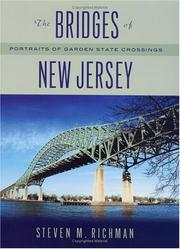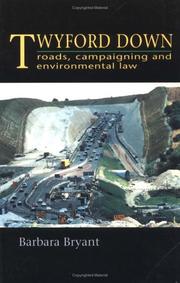| Listing 1 - 10 of 45 | << page >> |
Sort by
|
Book
ISBN: 1619429128 Year: 2012 Publisher: New York : Nova Publishers,
Abstract | Keywords | Export | Availability | Bookmark
 Loading...
Loading...Choose an application
- Reference Manager
- EndNote
- RefWorks (Direct export to RefWorks)
Traffic congestion --- Express highways --- Management --- Europe. --- Singapore.
Book
ISBN: 9781469642475 1469642476 1469642468 9781469642468 Year: 1997 Publisher: Boone, North Carolina : Appalachian Consortium Press,
Abstract | Keywords | Export | Availability | Bookmark
 Loading...
Loading...Choose an application
- Reference Manager
- EndNote
- RefWorks (Direct export to RefWorks)
Parkways --- Design and construction --- Express highways --- Park districts --- Parks --- Roads
Book
Year: 1956 Publisher: Washington, D.C. : U.S. Government Printing Office,
Abstract | Keywords | Export | Availability | Bookmark
 Loading...
Loading...Choose an application
- Reference Manager
- EndNote
- RefWorks (Direct export to RefWorks)
Committee Serial No. 84-16.
Roads --- Express highways --- Law and legislation. --- Law and legislation
Book
ISBN: 1609384229 9781609384227 1609384210 9781609384210 Year: 2016 Publisher: Iowa City, Iowa : University Of Iowa Press,
Abstract | Keywords | Export | Availability | Bookmark
 Loading...
Loading...Choose an application
- Reference Manager
- EndNote
- RefWorks (Direct export to RefWorks)
Automobile travel --- Roads --- Express highways --- History. --- Jefferson Highway
Book
ISBN: 0262526778 0262018586 0262312387 1283938871 9780262312387 0262312395 9780262018586 9781283938877 Year: 2013 Publisher: Cambridge, Massachusetts
Abstract | Keywords | Export | Availability | Bookmark
 Loading...
Loading...Choose an application
- Reference Manager
- EndNote
- RefWorks (Direct export to RefWorks)
The story of the evolution of the urban freeway, the competing visions that informed it, and the emerging alternatives for more sustainable urban transportation.Urban freeways often cut through the heart of a city, destroying neighborhoods, displacing residents, and reconfiguring street maps. These massive infrastructure projects, costing billions of dollars in transportation funds, have been shaped for the last half century by the ideas of highway engineers, urban planners, landscape architects, and architects--with highway engineers playing the leading role. In Changing Lanes, Joseph DiMento and Cliff Ellis describe the evolution of the urban freeway in the United States, from its rural parkway precursors through the construction of the interstate highway system to emerging alternatives for more sustainable urban transportation.DiMento and Ellis describe controversies that arose over urban freeway construction, focusing on three cases: Syracuse, which early on embraced freeways through its center; Los Angeles, which rejected some routes and then built I-105, the most expensive urban road of its time; and Memphis, which blocked the construction of I-40 through its core. Finally, they consider the emerging urban highway removal movement and other innovative efforts by cities to re-envision urban transportation.
Express highways -- Government policy -- United States -- History. --- Express highways -- United States -- History. --- Express highways --- Business & Economics --- Transportation Economics --- History --- Government policy --- History. --- Controlled access highways --- Express roads --- Expressways --- Freeways --- Interstate highways --- Interstates (Express highways) --- Limited access highways --- Motorways --- Superhighways --- Turnpikes (Modern) --- Roads --- Toll roads --- Government policy&delete& --- E-books --- ARCHITECTURE/Urban Design --- ENVIRONMENT/General --- URBANISM/Transportation
Book
ISBN: 9781469641997 1469641992 1469641968 9781469641966 Year: 1995 Publisher: Boone, North Carolina : Appalachian Consortium Press,
Abstract | Keywords | Export | Availability | Bookmark
 Loading...
Loading...Choose an application
- Reference Manager
- EndNote
- RefWorks (Direct export to RefWorks)
Parkways --- Greenways --- Design and construction --- Linear parks --- Open spaces --- Express highways --- Park districts --- Parks --- Roads

ISBN: 1280462817 9786610462810 0813537827 9780813537825 9780813535104 0813535107 9781280462818 Year: 2005 Publisher: New Brunswick, N.J. Rutgers University Press
Abstract | Keywords | Export | Availability | Bookmark
 Loading...
Loading...Choose an application
- Reference Manager
- EndNote
- RefWorks (Direct export to RefWorks)
New Jersey is sandwiched between the Hudson and Delaware Rivers, with the Raritan, Passaic, and Navesink cutting swaths across it. In spite of the state's relatively small size, over six thousand bridges span its varied landscape. They traverse rivers, streams, railroads, and roadways. Several dozen bridges cut across the Delaware River alone, carrying pedestrian, vehicular, and railroad traffic. Three connect the state to Staten Island. Some are steeped in history, dating back to the colonial era and the Revolutionary war. Others are recognized worldwide for their size or significance in the annals of engineering. In The Bridges of New Jersey, Steven M. Richman provides a rare photographic and poetic journey across sixty of the state's bridges, ranging from impressive suspension spans such as the Ben Franklin and George Washington Bridges, to the small wrought iron and stone bridges that are cherished by local citizens. The book provides a rich diversity of stories that place the bridges in the context of New Jersey history and culture. Richman also explores the contribution New Jersey bridges have made to engineering-some of the most prominent engineers of the nineteenth and twentieth centuries either lived or established businesses in the Garden State or designed its bridges. Lavishly illustrated with over seventy photographs, this book is much more than a documentary survey. It is a visual portrait that beautifully captures the metaphoric significance and aesthetic pleasures of New Jersey's bridges, and indeed all bridges. Perhaps more than any other structure built by humans, bridges typify progress and they give us a sense of connectedness. The Bridges of New Jersey provides a compelling visual demonstration of these symbolic functions, as well as their practical purposes and engineering accomplishments.
Bridges --- Bridges, Highway --- Express highways --- Highway bridges --- Transportation --- Viaducts --- History --- History. --- E-books
Book
ISBN: 1947083392 9781947083394 Year: 2018 Publisher: New York : Momentum Press, LLC,
Abstract | Keywords | Export | Availability | Bookmark
 Loading...
Loading...Choose an application
- Reference Manager
- EndNote
- RefWorks (Direct export to RefWorks)
Bridges --- Long-span bridges --- Bridges, Long-span --- Bridges, Highway --- Express highways --- Highway bridges --- Transportation --- Viaducts --- Reliability.
Book
ISBN: 3110584522 311058705X 3110584425 Year: 2018 Publisher: München ; Wien : De Gruyter Oldenbourg,
Abstract | Keywords | Export | Availability | Bookmark
 Loading...
Loading...Choose an application
- Reference Manager
- EndNote
- RefWorks (Direct export to RefWorks)
Die sowjetische Blockade Berlins gehört zu den großen Wendepunkten in der Geschichte des Kalten Krieges. Das Hauptaugenmerk der internationalen Forschung gilt dabei bis heute den beiden Supermächten. Großbritannien wird je nach Blickwinkel eine Rolle zwischen Defätismus und Komplizenschaft der westlichen Hegemonialmacht beigemessen.Auf einer breiten Quellengrundlage untersucht Victor Mauer erstmals systematisch die britische Krisenpolitik. Dabei fragt er nach den Akteuren, ihren Handlungsspielräumen und Handlungszwängen, beleuchtet widerstreitende Motive und Interessen, analysiert Verhandlungsstrategien und taktisches Kalkül, arbeitet institutionalisierte und informelle Entscheidungsprozesse heraus, widmet sich der Rolle von Öffentlichkeit und Medien, identifiziert wirkmächtige historische Narrative als Mobilisierungsressource, die dem öffentlichen Bedürfnis nach Komplexitätsreduktion in Krisenzeiten entsprach, und betont die Gleichzeitigkeit der Gegensätze.Die Studie revidiert nicht nur unser Bild von der britischen und damit zugleich von der westlichen Politik während der Blockade Berlins. Sie führt auch zu einer Neubewertung der britischen Deutschlandpolitik, ohne die die Krisenpolitik nicht zu verstehen ist. On the occasion of the 70th anniversary of the Soviet blockade, a well-sourced study of British crisis policy is being published for the first time, and it yields surprising new insights. Victor Mauer's work revises our notions of British (and thus Western) policy during the Berlin blockade. It also suggests the need to re-evaluate the history of Britain's German policy, without which we cannot understand the crisis policy.
Bridges --- Bridges, Highway --- Express highways --- Highway bridges --- Transportation --- Viaducts --- Cold War. --- crisis management. --- foreign policy.

ISBN: 113582049X 1138424498 1280404914 9786610404919 0203475712 0203237706 9780203237700 9780203475713 9780419202707 0419202706 0419202706 9781135820497 9781135820442 1135820449 9781135820480 1135820481 9781138424494 Year: 1996 Publisher: London New York E & FN Spon
Abstract | Keywords | Export | Availability | Bookmark
 Loading...
Loading...Choose an application
- Reference Manager
- EndNote
- RefWorks (Direct export to RefWorks)
The Twyford Down story is set in a political and historical framework in order to examine the key issues affecting road planning and environmental protection: the system of route selection; Crown development; government agents, NGOs and locally elected authorities; conservation legislation; subsidiarity; lobbying techniques; and the role of the press. Written in a lively style and vividly illustrated, Twyford Down will appeal to environmental advisors, policy makers and planners as well as lobbyists and those interested in the environment.
Express highways --- Controlled access highways --- Express roads --- Expressways --- Freeways --- Interstate highways --- Interstates (Express highways) --- Limited access highways --- Motorways --- Superhighways --- Turnpikes (Modern) --- Roads --- Toll roads --- Design and construction --- Environmental aspects --- Political aspects
| Listing 1 - 10 of 45 | << page >> |
Sort by
|

 Search
Search Feedback
Feedback About UniCat
About UniCat  Help
Help News
News